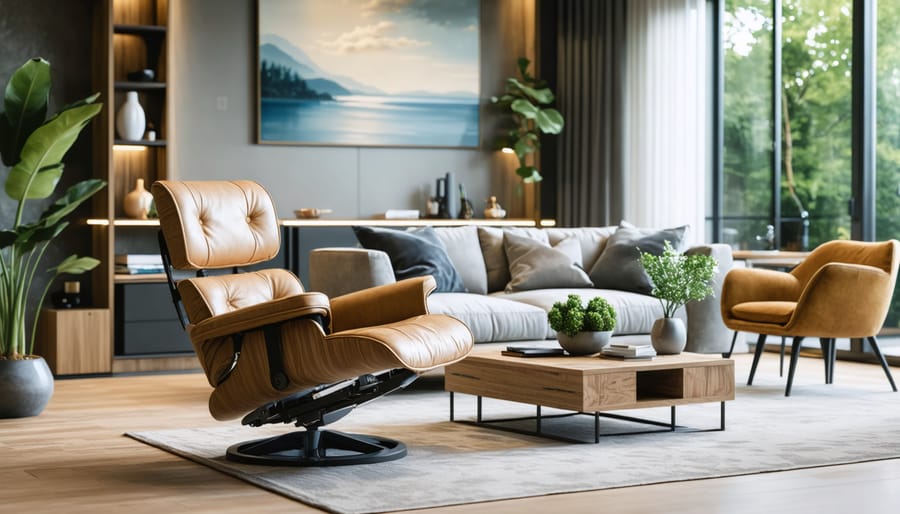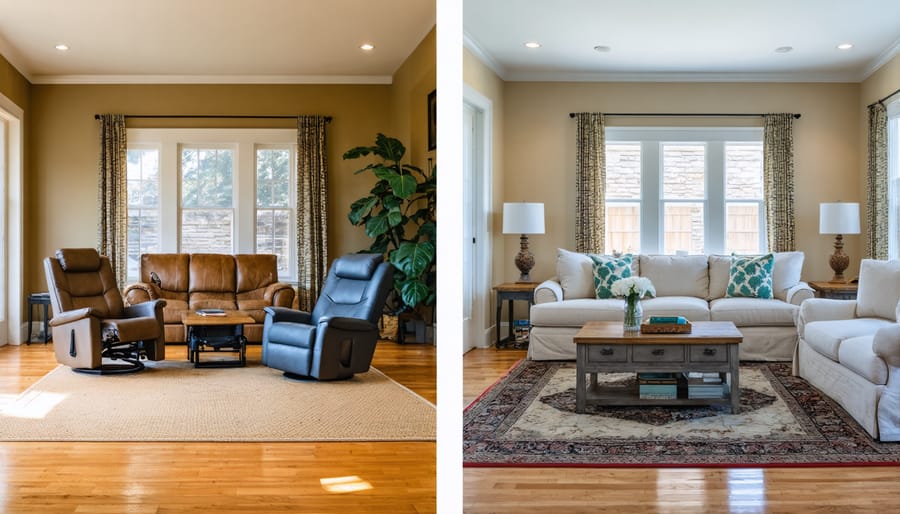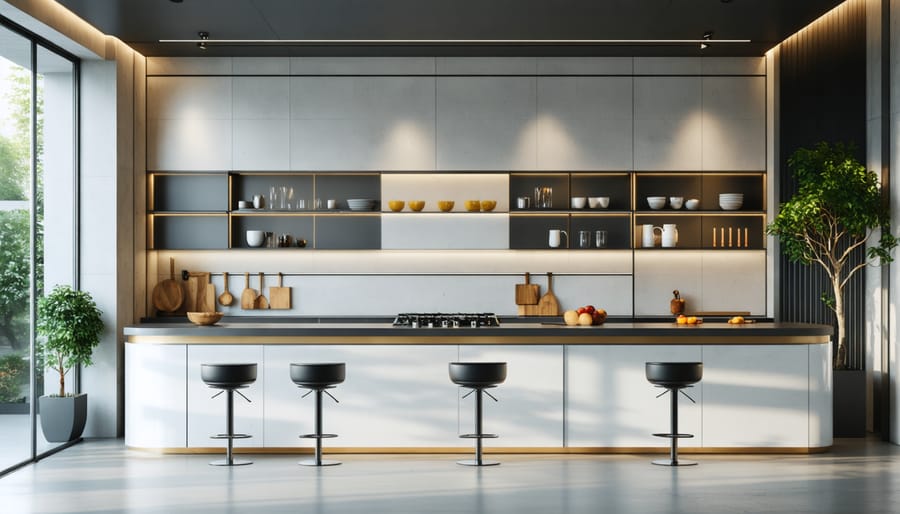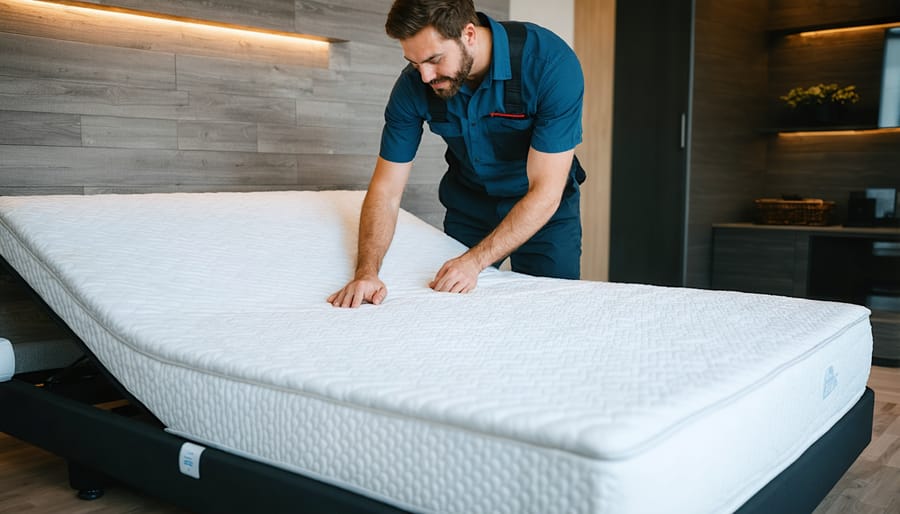
Transform living spaces into safer, more accessible environments without sacrificing style or comfort through strategic adaptive renovations. Modern solutions for aging safely at home now integrate seamlessly with contemporary design, offering both functionality and aesthetic appeal. From motion-activated lighting systems and zero-threshold showers to adjustable-height countertops and smart furniture solutions, these modifications enhance independence while maintaining property value.
Professional adaptive living renovations address three critical aspects: mobility support, accident prevention, and everyday task simplification. Installing grab bars that double as elegant towel racks, replacing traditional doorknobs with lever-style handles, and incorporating pull-out shelving in lower cabinets represent just the beginning of possible modifications. These thoughtful changes create living spaces that adapt to changing needs while preserving dignity and independence.
The growing demand for adaptive living solutions reflects a broader shift toward inclusive design principles that benefit all residents, regardless of age or ability. Whether planning for future needs or addressing immediate accessibility concerns, these renovations represent an investment in both safety and quality of life.
Adaptive furniture represents a cornerstone of modern accessible living, featuring innovative designs that accommodate varying needs and abilities. The hallmark of these pieces is their adjustability, with motorized or manual mechanisms allowing for seamless height modifications of tables, chairs, and work surfaces. Multi-position recliners and lift chairs incorporate powerful yet quiet motors, enabling smooth transitions between sitting and standing positions while maintaining optimal support.
Safety features are seamlessly integrated through enhanced stability systems, non-slip surfaces, and reinforced weight-bearing capabilities. Strategic placement of grab bars and support rails provides additional security without compromising aesthetic appeal. Ergonomic designs focus on proper body alignment and pressure distribution, incorporating memory foam and specialized cushioning to prevent discomfort during extended use.
Many pieces feature modular components that can be easily reconfigured as needs change, while smart storage solutions ensure frequently used items remain within comfortable reach. Anti-tip mechanisms and rounded edges provide additional safety measures, while moisture-resistant materials and antimicrobial surfaces facilitate easy maintenance and promote hygiene.
Adaptive furniture modifications significantly enhance daily living by addressing critical safety concerns while maintaining independence and dignity. These thoughtful adaptations include features like enhanced lighting under cabinets, soft-close mechanisms on drawers, and anti-tip furniture anchoring systems that prevent dangerous accidents. For individuals with mobility challenges, adjustable-height tables and chairs with stable arms provide crucial support during transfers, while rounded corners and padded edges reduce injury risks.
Accessibility improvements extend beyond basic safety features. Pull-out shelving in lower cabinets eliminates the need for deep bending, while lever-style handles replace traditional knobs for easier gripping. Remote-controlled reclining mechanisms and power-lift chairs enable smooth transitions from sitting to standing positions, particularly beneficial for those with arthritis or limited strength.
These modifications also support caregivers by reducing physical strain and creating more efficient care environments. Strategic furniture placement ensures clear pathways for mobility devices while maintaining an open, welcoming atmosphere. The result is a living space that seamlessly combines safety features with aesthetic appeal, promoting both independence and peace of mind.
Creating a comfortable and accessible living room environment starts with selecting the right furniture and storage solutions. Modern healthcare furniture solutions have revolutionized how we approach adaptive living spaces, offering both functionality and style.
Lift chairs represent a cornerstone of living room modifications, providing essential support for individuals with mobility challenges. These chairs feature powerful motors that smoothly transition from sitting to standing positions, reducing strain on joints and muscles. Available in various styles and fabrics, they seamlessly blend with existing décor while offering critical assistance.
Adjustable seating options extend beyond lift chairs to include modular sofas with customizable heights and supportive cushions. These pieces can be easily modified to accommodate changing needs, featuring removable armrests, adjustable backrests, and enhanced lumbar support.
Storage accessibility plays a crucial role in maintaining independence. Pull-down shelving units, carousel corner cabinets, and sliding drawer systems bring items within easy reach. Consider installing touch-latch mechanisms on cabinet doors and incorporating pull-out baskets at wheelchair height for convenient access to frequently used items.
By integrating these thoughtful modifications, living rooms become more welcoming and functional spaces that support independent living while maintaining the warmth and comfort of home. Our design specialists can help create custom solutions that perfectly balance accessibility with aesthetic appeal.

The bedroom should be a sanctuary of comfort and independence, which is why adaptations in this space are crucial for maintaining quality of life. Adjustable beds represent one of the most significant improvements you can make, offering electric controls for head and foot positioning, making it easier to get in and out of bed independently. Many modern models include features like massage functions and preset comfort positions, enhancing both functionality and relaxation.
Strategic placement of bedside furniture enhances accessibility while maintaining a stylish appearance. Consider C-shaped rolling tables that can slide under the bed, providing a stable surface for meals, electronics, or reading materials. Height-adjustable nightstands with built-in charging stations keep essential items within easy reach while eliminating cord clutter.
Storage solutions should prioritize ease of access without requiring bending or stretching. Pull-down closet rods bring hanging clothes to a comfortable height, while drawer systems with soft-close mechanisms and large handles make daily dressing routines more manageable. Installing motion-sensor lighting under beds and in closets improves visibility and safety during nighttime activities.
For maximum effectiveness, bedroom adaptations should be personalized to individual needs. Built-in bed rails can be disguised with decorative panels, and transfer poles can be integrated into the room’s design scheme. The key is creating modifications that support independence while maintaining the bedroom’s peaceful atmosphere.
The kitchen and dining areas present unique challenges for individuals with varying mobility needs, but modern adaptive solutions make these spaces both functional and welcoming. Height-adjustable countertops have revolutionized kitchen accessibility, offering electronic controls that can shift working surfaces from standard height to wheelchair-accessible levels with the touch of a button.
Pull-down shelving systems transform hard-to-reach upper cabinets into easily accessible storage spaces. These mechanical units smoothly lower shelf contents to counter level, eliminating the need for step stools or dangerous reaching. Base cabinets can be modified with pull-out drawers and lazy Susans, ensuring that every inch of storage space remains usable regardless of mobility limitations.
Adaptive dining furniture combines style with practicality through adjustable-height tables and chairs with swivel seats. These pieces feature enhanced stability and support while maintaining an elegant appearance that complements any décor style. Chairs with firm armrests and proper seat heights facilitate safe transfers, while tables with C-shaped or pedestal bases accommodate wheelchairs comfortably.
Task lighting is another crucial element, with under-cabinet LED strips and adjustable pendant lights ensuring proper illumination of work surfaces. Anti-scald devices on faucets and touch-activated controls add additional safety measures while maintaining independence in daily kitchen activities.

When adapting bathrooms for accessibility, vanity and storage modifications play a crucial role in ensuring both safety and convenience. Consider installing floating vanities that allow wheelchair access underneath, or adjustable-height countertops that accommodate multiple users with different needs. These modifications create a more inclusive space while maintaining style and functionality.
Storage solutions should prioritize easy reach and organization. Install pull-out drawers instead of deep cabinets to eliminate the need for bending or reaching into dark spaces. Consider adding motion-sensor lights inside drawers and cabinets for better visibility. Wall-mounted storage units at appropriate heights reduce strain and prevent accidents from overreaching.
For enhanced safety, opt for rounded corners on all vanity surfaces and choose hardware with easy-grip handles. Anti-slip mats inside drawers keep items secure, while soft-close mechanisms prevent pinched fingers. Installing mirrors at various heights or adjustable mirrors accommodates users whether seated or standing.
To maximize space efficiency, consider vertical storage solutions that make use of wall space without creating obstacles. Built-in hampers, medicine cabinets with magnetic strips for frequently used items, and pull-out grooming stations can be seamlessly integrated into your bathroom design. These thoughtful modifications not only improve accessibility but also add value to your home while maintaining a sophisticated appearance.
Selecting the right installation team for your adaptive living modifications is crucial for ensuring safety, functionality, and longevity. Start by verifying that potential contractors have specific experience with adaptive furniture and mobility solutions. Look for teams that hold relevant certifications in universal design or aging-in-place modifications, such as those offered by the National Association of Home Builders (NAHB).
Ask for detailed portfolios showcasing their previous adaptive living projects and furniture restoration services. Professional installers should be willing to provide references from past clients who have received similar modifications.
When interviewing potential teams, pay attention to their communication style and willingness to understand your specific needs. They should ask detailed questions about the intended users’ mobility requirements and daily routines. The best installation teams will conduct thorough home assessments and provide comprehensive proposals that include timeline estimates and clear pricing structures.
Insurance and licensing are non-negotiable factors. Ensure the team carries adequate liability insurance and maintains current local licensing requirements. They should also be familiar with ADA guidelines and local building codes related to accessibility modifications.
Consider their post-installation support as well. Quality teams will offer warranties on their work and be available for adjustments or maintenance as needs change over time. Remember, the right installation team becomes a valuable partner in creating a safe and comfortable living environment.

Regular maintenance is crucial for ensuring the longevity and optimal performance of adaptive living solutions. Start by implementing a quarterly inspection routine of all modified furniture and fixtures, checking for loose hardware, wear patterns, and any signs of structural weakness. Pay special attention to high-use items like lift chairs, adjustable beds, and modified cabinets.
Keep moving parts well-lubricated according to manufacturer specifications, typically using food-grade silicone lubricants for safety. Clean tracks and mechanisms monthly to prevent debris buildup that could affect smooth operation. For upholstered pieces, treat fabrics with appropriate protectants and clean spills immediately to prevent staining and deterioration.
Electronic components require particular attention. Test backup batteries in powered furniture monthly and replace them annually, even if they appear functional. Keep charging ports and electrical connections free from dust and inspect cords regularly for wear.
Document all maintenance activities and keep manufacturer guidelines readily accessible. Consider establishing a maintenance agreement with a qualified service provider for annual professional inspections and servicing. This proactive approach helps identify potential issues before they become serious problems.
For wooden components, maintain consistent humidity levels to prevent warping or joint separation. Use appropriate cleaning products that won’t damage specialized surfaces or compromise safety features. Regular maintenance not only extends the life of adaptive furniture but also ensures continued safety and functionality for users.
Adapting your living space with flexible furniture solutions isn’t just about addressing immediate needs – it’s an investment in your future comfort and independence. By incorporating versatile pieces and modular designs, you create a living environment that evolves with your changing requirements while maintaining style and functionality. The benefits extend beyond practical considerations, offering peace of mind and potentially increasing property value.
Taking a proactive approach to adaptive living renovations allows you to make thoughtful decisions without the pressure of urgent needs. Start by assessing your space and identifying areas where adaptable furniture could make the most impact. Consider consulting with design professionals who specialize in adaptive solutions to develop a comprehensive plan that accounts for both current and future needs.
Remember that successful adaptive living spaces maintain a balance between functionality and aesthetics. With today’s innovative furniture designs, you don’t have to compromise on style to achieve accessibility. By planning ahead and choosing quality adaptive solutions, you’re creating a smart, sustainable living environment that supports independence and enhances quality of life for years to come.